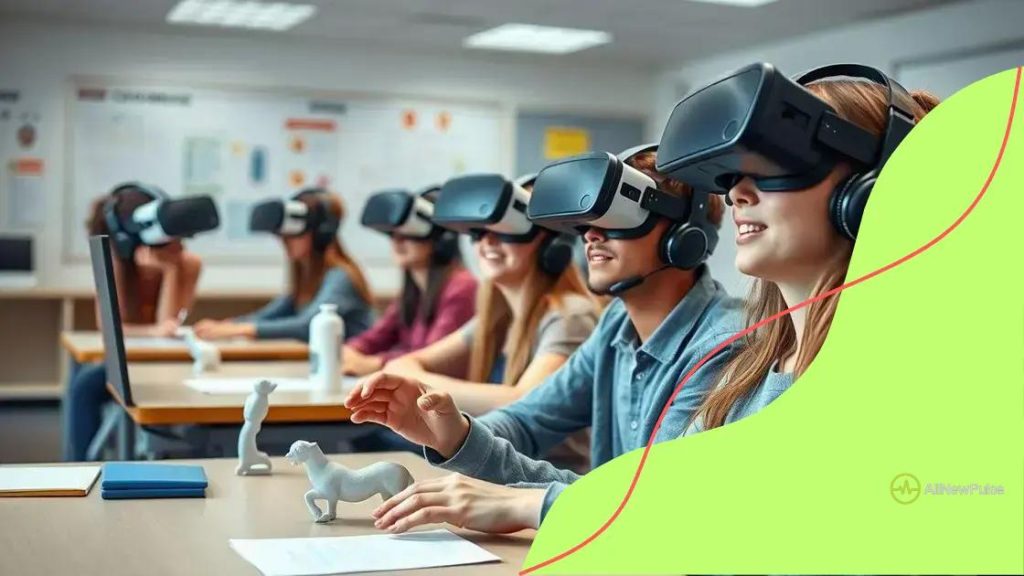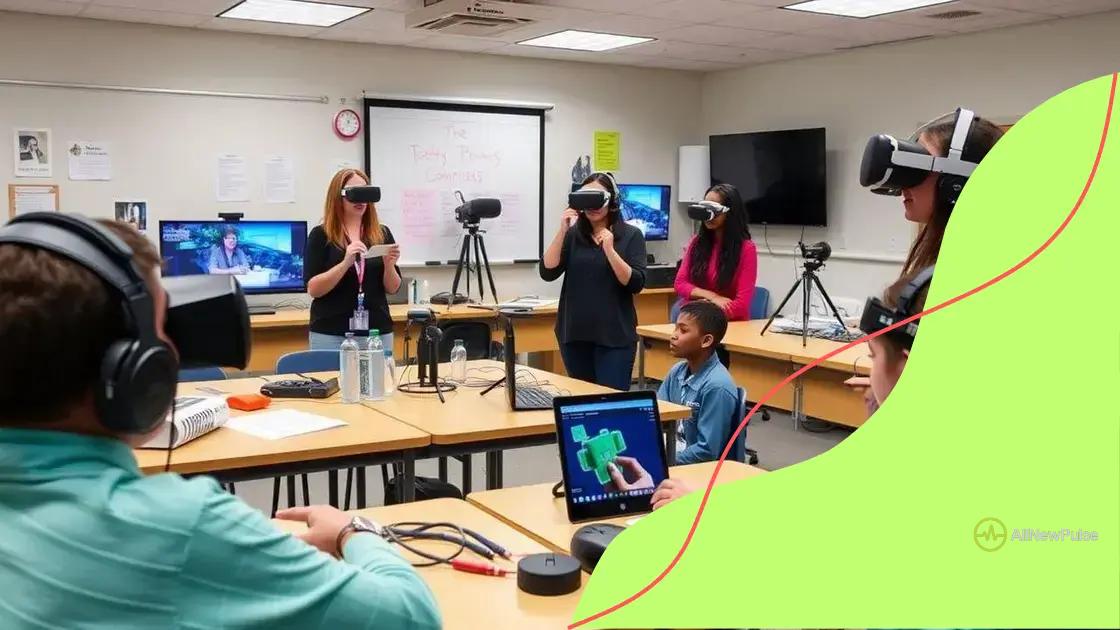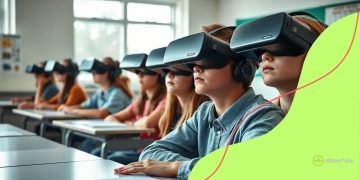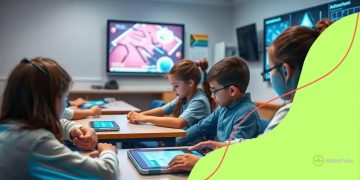Integration of virtual reality in educational settings

The integration of virtual reality in educational settings enhances student engagement and understanding, but challenges such as cost, technical expertise, and content availability must be addressed for successful implementation.
Integration of virtual reality in educational settings presents exciting opportunities for enhancing the learning process. Imagine students exploring ancient civilizations or the depths of the ocean without leaving the classroom. Intrigued? Let’s dive into how this technology can transform education.
Understanding virtual reality technology
Understanding virtual reality technology is essential for grasping how it can transform education. Virtual reality (VR) immerses users in a 3D environment where they can interact with digital elements as if they were real.
VR technology uses special headsets and controllers to create a sense of presence in a virtual world. With this technology, learners can engage in realistic scenarios, enhancing their understanding of complex subjects. Imagine studying the human body through a detailed 3D model instead of just reading about it in a textbook.
Components of Virtual Reality
The main components that make up VR include:
- Headsets: Devices such as Oculus Rift or HTC Vive that display the virtual environment.
- Sensors: Track movement and position to ensure an immersive experience.
- Software: Programs that create the virtual environments and scenarios for educational purposes.
These components work together to offer a unique learning experience. VR also allows educators to introduce hands-on experience in subjects like science, history, and art, which are often hard to visualize through traditional methods.
How Virtual Reality Works in Education
In an educational setting, students can participate in simulations and exercises that mimic real-life situations. For instance, VR can take students on virtual field trips to distant places without the logistical challenges of travel. They can witness history unfolding or explore ecosystems in a way that is engaging and memorable.
The role of interactive learning cannot be overstated. Virtual reality encourages experimentation and exploration, making learning not just informative but exciting. By incorporating gamification elements into the education process, learners are more motivated to engage and succeed.
Ultimately, understanding VR technology helps educators see its value. By embracing this innovative approach, they can cultivate a rich learning experience that keeps students interested and eager to learn more.
Benefits of VR in education
Benefits of VR in education are profound and can change how students learn. By integrating virtual reality into the classroom, educators can create immersive experiences that make learning more engaging and effective.
One key benefit is enhanced engagement. Students find it easier to connect with subjects when they can experience them firsthand in a virtual environment. This increases their interest and motivation to learn more, as they feel like active participants in their education.
Improved Retention of Information
Research shows that students remember information better when it is presented in an interactive way. Virtual reality allows for experiential learning, which means that students can practice skills and apply knowledge in a realistic setting.
- Visual Learning: Seeing and interacting with 3D models helps in understanding complex concepts.
- Hands-on Experience: Students can practice in a safe environment without real-world consequences.
- Immediate Feedback: VR systems often provide instant responses to actions, enhancing the learning loop.
This shift from passive to active learning is a game-changer. Another benefit is the ability to cater to different learning styles. Whether a student learns best visually, audibly, or through kinesthetic means, VR can address these preferences.
Accessibility and Inclusion
Virtual reality can also bridge gaps for students with disabilities. It offers accessibility that traditional methods may lack, making it easier for all students to participate in learning activities.
Equity in education can be enhanced by VR, allowing diverse groups to explore topics together in an inclusive setting. Each student can engage at their own pace and comfort level, which fosters a supportive learning environment.
Lastly, VR technology prepares students for the future. By familiarizing them with advanced technology, educators are equipping learners with the necessary skills for the evolving job market.
Best practices for implementing VR

Best practices for implementing VR in educational settings can help maximize its benefits and effectiveness. When educators and institutions decide to adopt virtual reality, it is crucial to plan and execute the implementation carefully to ensure that the technology enhances learning experiences.
First, it is important to define clear goals for using VR. Decide what subjects or skills you want to focus on, and how VR can help achieve these educational objectives. This targeted approach ensures that the technology is used effectively and meets the needs of the students.
Choosing the Right VR Tools
The selection of appropriate VR tools and software is key. Research various options on the market to find programs that best align with the learning goals.
- Hardware Compatibility: Ensure that the VR devices you choose work well with your existing technology.
- User-Friendly Software: Opt for platforms that are easy for both teachers and students to navigate.
- Content Variety: Select software that offers a range of educational content suitable for different subjects and grade levels.
Another best practice is to integrate VR into the curriculum seamlessly. It should complement traditional teaching methods rather than overwhelm them. By blending VR with other instructional strategies, educators can enhance student learning while still maintaining the benefits of conventional education.
Training Educators
Training teachers is often overlooked but is crucial for the success of VR implementation. Educators should be comfortable using the technology and understand how to incorporate it into their lessons effectively. Consider providing workshops or training sessions to familiarize educators with the tools and potential applications.
Creating a supportive environment for students is also vital. Encourage them to ask questions and provide feedback about their experiences with VR. This can lead to valuable insights and adjustments that enhance the learning process. Additionally, be open to adapting your approach based on student feedback to better meet their needs.
Lastly, regularly assess the impact of VR in your teaching practices. Collect data on student engagement, understanding, and retention of knowledge. This information can help you refine your approach and demonstrate the value of incorporating VR in education.
Case studies of successful VR integration
Case studies of successful VR integration highlight the transformative effects of virtual reality in education. Various schools and institutions have successfully used this technology to enhance learning outcomes and student engagement.
One notable example is a high school that implemented VR in its science curriculum. By using VR simulations, students explored human anatomy in 3D. This immersive experience allowed them to visualize complex systems like the circulatory and respiratory systems, leading to a deeper understanding and higher test scores.
Elementary School Project
In an elementary school, teachers introduced VR field trips that took students to historical landmarks worldwide. Virtual trips to places like ancient Rome or the Great Wall of China captivated young learners. The excitement created around these lessons increased participation and sparked interest in history.
- Engagement: Students were more eager to learn about history as they could interact with the environment.
- Real-life understanding: This method helped children connect classroom lessons with real-world settings.
- Inclusion: VR allowed students of varying abilities to travel and learn together.
Another example comes from a university using VR for nursing training. Students participated in realistic patient simulations, where they could practice clinical skills without risk. This hands-on approach boosted their confidence and preparedness for real-life medical scenarios.
Impact on Learning
The success of these case studies shows that VR is not just a novelty; it has the potential to change the educational landscape significantly. Teachers reported that lessons became more interactive, and students retained information better when using VR technology.
In addition, educators found that these experiences foster collaboration among students. Working in groups during VR activities built teamwork skills while enhancing their understanding of course material.
Overall, successful VR integration demonstrates its impact on engagement and retention. These case studies provide valuable lessons for educators aiming to implement VR in their own classrooms.
Challenges faced in virtual reality adoption
Challenges faced in virtual reality adoption can hinder its integration into educational settings. While virtual reality offers exciting possibilities, several obstacles must be addressed for successful implementation.
One major challenge is the cost of technology. Purchasing VR headsets and required software can be expensive for many institutions. Not only do schools need to invest in equipment, but they must also consider ongoing maintenance and updates.
Technical Limitations
Another significant issue is the technical know-how required to set up and manage VR systems. Educators must be trained to use the technology effectively. If teachers are not comfortable with VR, they may hesitate to integrate it into their lessons.
- Integrating with Existing Systems: Ensuring compatibility with current learning management systems can be complicated.
- Internet Bandwidth: Efficient VR experiences often rely on high-speed internet, which may not be available in all areas.
- Hardware Limitations: Schools may face difficulties in maintaining and upgrading hardware to support advanced VR applications.
Additionally, there is a concern regarding student safety. When using VR, students can become disoriented or overstimulated. Educators must establish guidelines for safe usage to prevent accidents or discomfort during sessions.
Content Availability
The availability of engaging and appropriate educational content is another hurdle. While some VR applications exist for various subjects, educators often find a limited selection that meets their curriculum needs. This scarcity of high-quality content can restrict the use of VR in certain grades or subjects.
Moreover, there is a challenge in ensuring accessibility for all students. Not every student may be able to use VR equipment due to physical limitations or other concerns. Educators must think of inclusive strategies to ensure all learners can benefit from VR experiences.
Lastly, there is an ongoing need for evidence of effectiveness. Schools may need proof of VR’s benefits before committing to large-scale purchases. Finding reliable studies and results can be essential for convincing decision-makers to support VR integration.
FAQ – Frequently Asked Questions about VR in Education
What are the main benefits of using VR in the classroom?
VR enhances engagement by immersing students in interactive learning environments, leading to better retention and understanding of concepts.
What challenges do schools face when adopting VR technology?
Schools often encounter financial constraints, technical issues, and the need for appropriate training for educators.
How can VR help students with different learning styles?
VR supports various learning preferences by providing visual, auditory, and kinesthetic experiences tailored to individual needs.
What should schools consider before implementing VR?
Schools need to evaluate their budget, available content, safety measures, and ensure that teachers are trained to use VR effectively.





